A Hybridizer's Guide to Bearded Species |
This is a sort of checklist of bearded species, with particular
emphasis on the chromosome configuration of each, the fertile
families, and potential uses in hybridizing. Please note that
different botanical references frequently disagree regarding which
names should be regarded as true species and which are synonyms or
forms of other species. I do not make any judgments on these matters,
but for ease of use I have grouped closely related species under a
single listing, with cross-referencing from the various other
names.
A Hybridizer's Guide to
Bearded Species
It is also important to bear in mind that many of the bearded species are quite variable in flower and plant characteristics, and often grow where other related species also occur, sometimes giving rise to natural hybrids. Irises escaped from cultivation compound the difficulty of identifying plants in the wild. Hence, one cannot always be confident that the plants now in circulation correspond closely to those originally described by botanists or those used for chromosome counting.
There are five fertile families among the bearded irises: PP (Ii. attica and pseudopumila), TT (Ii. pallida, diploid reichenbachii, suaveolens, variegata, and others, plus diploid MTBs); PPPP (I. pumila), PPTT (I. lutescens plus SDBs and many modern MDBs), and TTTT (Ii. aphylla, croatica, mesopotamica, tetraploid reichenbachii, schachtii, and others, plus TBs, BBs, and tetraploid MTBs). For more background on chromosome configuration and fertile families, see 31 Ways to Build an Iris and Chromosomes: Concepts and Terminology.
For more information on each of these species, including photographs, visit the AIS Iris Encyclopedia or the SIGNA Species Database.
horticultural
class: BB chromosome
configuration: TT:24 fertility: fertile
Distribution: central Asia
Distinctive characteristics:
A diploid TB, flowers rosy lavender, blooms early.
Expected to produce fertile offspring with diploid MTBs and other TT species.
Uses in hybridizing: Except for a few hybrids with I. pallida, and an appearance in the pedigree of Rodionenko's IB 'Temuri', this species has not been much used. Diploid species are generally of most interest to MTB breeders, and the smaller, more delicate species no doubt have more to contribute in this area.
horticultural
class: SDB/IB chromosome
configuration: PTTT:44 fertility:
limited
Distribution: Mediterranean countries, Arabian peninsula.
Distinctive characteristics: white flowers, short, spur-like branches.
This is the iris originally referred to as Iris florentina in European literature. It is traditionally planted by graves in Islamic countries, and is probably an ancient natural hybrid between a 48-chromosome TB species and I. lutescens. It has been reported that plants in circulation in the US are TT:24 diploids.
See I. pumila.
horticultural
class: SDB/IB chromosome
configuration: TTTT:48 fertility: fertile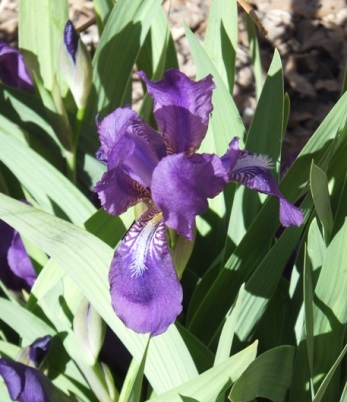
Distribution: central and eastern Europe, Ukraine, Russia, and into
the Caucasus
Distinctive characteristics: copious branching, first branch from below the middle of the stalk.
This is one of the mostly widely grown small bearded species, and aside from I. pumila certainly the one most used in hybridizing. Flowers are purple in most forms, although lavender, bitone, and white forms also exist, and there is a dull yellow that has been registered as 'Yellow Conundrum'. There is considerable variation in height and in the size of flowers, foliage, and rhizomes. Authorities disagree as to which if any of the various forms should be regarded as distinct species. Here are a few of these designations of uncertain status:
I. babadagica a diminutive purple or white form native to Mt. Babadag in the eastern Caucusus. Although I am not aware of any chromosome count reported for this iris, most references comment on its similarity to I. furcata, which suggests it may be a TT diploid. (See also separate entry below.)
I. bohemica
I. furcata an eastern form from Moldavia, Ukraine, Russia, and the Caucusus, smaller than most western types. It was counted as a TT:24 diploid, which would suggest it is a distinct species. (See also separate entry below.)
I. hungarica
I. perrieri is a small aphylla-type iris native to the French Alps, distinguished by relatively high branching in the wild. It was counted as a TT:24 diploid, which would suggest it is a distinct species. (See also separate entry below.)
I. polonica
Whether or not these are regarded as forms, varieties, suspecies, or separate species, they do have distinctive qualities, and hybridizers interested in working with I. aphylla can benefit by acquiring a collection of different types.
I. aphylla was used historically in the development of modern black and dark violet TBs. Ben Hager, and later Jim and Vicki Craig, have used it with considerable success to produce tetraploid MTBs and other medians that are part of the TB/BB fertile family.
Expected to produce fertile offspring when crossed with TBs, BBs, tetraploid MTBs, and other TTTT species. Also expected to produce fertile offspring when crossed with I. pumila (offspring are members of the PPTT family, which includes the standard dwarfs). Crossing with regelias or other tetraploid arils is expected to produce AATT amphidiploid arilbreds (members of the fertile family that includes the fertile C. G. White arilbreds and their descendents).
Uses in hybridizing: many. Although there is probably not much value in reproducing what Hager and the Craigs have already done in their MTB lines, there is room to work with the smaller (SDB-sized) end of these lines, especially if some of the more recently available small TTTT species (I. schachtii, for example) are also used. There is also a largely unexplored potential for well-branched arilbred medians from using I. aphylla with tetraploid arils and breeding the offspring with smaller C. G. White - type arilbreds. The use of aphylla/pumila hybrids in MDB breeding may also have potential.
horticultural
class: MDB chromosome
configuration: PP:16 fertility: fertile
Distribution: Greece, Macedonia, southern Balkans,
Bosporus
Distinctive characteristics: falcate foliage, rounded bracts
This is a charming dwarf iris adapted to warm, dry climates. Colors range from purple and yellow to yellow/brown bicolors and blends, and white. It is one of the species from which I. pumila is thought to have arisen.
Expected to produce fertile offspring when crossed with I. pseudopumila.
Uses in hybridizing: limited, because of the expected sterility of offspring when outcrossed to most other species. Possibly a dedicated breeder could intercross the different forms of this species (and I. pseudopumila) and select cultivars of particular garden merit. It is unlikely that these would ever rival the many attractive cultivars of I. pumila, which fills the same niche in the garden. I plan to attempt crossing I. attica with diploid arils in the rather remote hope that the seedlings could contribute (via an unreduced gamete) to the amphidiploid arilpum family.
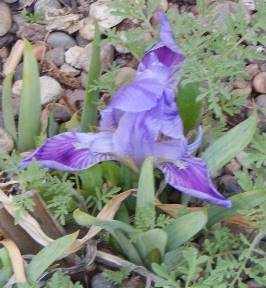
horticultural class: MDB chromosome
configuration: unknown, perhaps TT:24 fertility: fertile
Distribution: Mt. Babadag, Caucasus
Distinguishing characteristics:
This resembles a very small I. aphylla, with both violet and white color forms.
Expected to produce fertile offspring with diploid MTBs and other TT species.
Uses in hybridizng: Like other small TT species, this can be useful in MTB breeding in working for smaller size and better branching. Otherwise, its potential is limited as a diploid that is expected to produce sterile offspring in outcrosses to other types.
See I. reichenbachii.
horticultural
class: TB chromosome
configuration: TTTT:48 fertility: fertile
Distribution: Morocco
Distinctive characteristics:
A large tetraploid TB species with violet flowers. May no longer be in cultivation.
Expected to produce fertile offspring when crossed with TBs, BBs, tetraploid MTBs, and other TTTT species. Also expected to produce fertile offspring when crossed with I. pumila (offspring are members of the PPTT family, which includes the standard dwarfs). Crossing with Regelias or other tetraploid arils is expected to produce AATT amphidiploid arilbreds (members of the fertile family that includes the fertile C. G. White arilbreds and their descendents).
Uses in hybridizing: probably minimal.
horticultural
class: SDB/IB chromosome
configuration: PPTT:40 fertility: fertile
Distribution: Gargano Peninsula, Italy.
Distinctive characteristics:
Extremely variable in coloration, this plant has only recently been identified as a species and distributed. The chromosome count suggests it is related to I. lutescens, with which it had been formerly included. It is reported to be fertile.
Expected to produce fertile offspring with other members of the PPTT family (SDBs).
Uses in hybridizing: uncertain.
See I. pallida.
See I. lutescens.
See I. pumila.
horticultural
class: BB/TB chromosome
configuration: TTTT:48 fertility: fertile
Distribution: Balkans
Distinctive characteristics:
This is a large "germanica" type with wide, copious branching. Colors are shades of purple, often bitoned.
Expected to produce fertile offspring when crossed with TBs, BBs, tetraploid MTBs, and other TTTT species. Also expected to produce fertile offspring when crossed with I. pumila (offspring are members of the PPTT family, which includes the standard dwarfs). Crossing with Regelias or other tetraploid arils is expected to produce AATT amphidiploid arilbreds (members of the fertile family that includes the fertile C. G. White arilbreds and their descendents).
Uses in hybridizing: Its main value is probably in introducing good branching and bud count into median and arilbred lines. I would think, however, that selecting modern TBs and BBs with these qualities to use instead would be a more efficient parth toward the goal.
horticultural class: SDB chromosome
configuration: TT:24 fertility: fertile
Distribution: Southern Russia, Caucasus
Distinguishing characteristics: branches from near the middle of the stem, otherwise resembles I. aphylla.
Often regarded as a synonym of I. aphylla, this plant is somewhat more refined in appearance and is a diploid with chromosome morphology different from that of I. aphylla. Usually violet, although a light blue form exists.
Expected to produce fertile offspring with diploid MTBs and other TT species.
Uses in hybridizng: Like other small TT species, this can be useful in diploid MTB breeding in working for smaller size and better branching. Otherwise, its potential is limited as a diploid that is expected to produce sterile offspring in outcrosses to other types.
I. germanica
horticultural class: IB, BB,
TB chromosome
configuration: PTTT:44; TTTT:48 fertility: varies
Distribution: Europe, Turkey
The name Iris germanica has been used in a variety of ways. Most, if not all, of the plants referred to under this name are of garden origin, sometimes naturalized in sites of former habitation. The name most commonly refers to a violet bitoned iris of hybrid origin, a usually infertile 44-chromosome intermediate. Mathew has extended the scope of the name to include the taller 48-chromosome tetraploids collected in Turkey in the late 1800s: Ii. cypriana, mesopotamica, and trojana, the clones 'Ricardi' and 'Amas'. Iris kashmiriana and Iris croatica are also connected with this group. For the breeder, the classic intermediate 'Germanica' is of little interest. The 48-chromosome tetraploids are of historic interest, but their genetic legacy is already well represented in the modern TBs.
It is a common although erroneous practice in the horticulture trade to refer to all modern hybrid bearded irises as I. germanica.
Given the confusion surrounding the name, it seems best to avoid using it in favor of more precise taxon or cultivar names.
See I. pallida.
horticultural class:
SDB/IB chromosome
configuration: TT:24 fertility: fertile
Distribution: Transcaucasus
Distinctive characteristics: imbricated (overlapping; tiled) bracts
A yellowish median species.
Expected to produce fertile offspring with diploid MTBs and other TT species.
Uses in hybridizing: This irises has seen occassional use in median (diploid MTB) and TB breeding; a few SPEC-X hybrids have been introduced in recent years.

horticultural class: BB chromosome
configuration: TTTT:48 fertility: fertile
Distribution: Cilician Taurus, southern Turkey
Distinctive characteristics:
A median Turkish species, allied with I. schachtii and I. purpureobractea. Branched, flowers typically purple, white, or blended.
Expected to produce fertile offspring when crossed with TBs, BBs, tetraploid MTBs, and other TTTT species. Also expected to produce fertile offspring when crossed with I. pumila (offspring are members of the PPTT family, which includes the standard dwarfs). Crossing with Regelias or other tetraploid arils is expected to produce AATT amphidiploid arilbreds (members of the fertile family that includes the fertile C. G. White arilbreds and their descendents).
Uses in hybridizing: Potential similar to that of I. aphylla.
horticultural class: TB chromosome
configuration: TTTT:48 fertility: fertile
Distribution: Kashmir
Distinguishing characteristics:
This is a white TB species (occasionally light violet-blue), important in the development of the first tetraploid TBs. Purple-flowered plants presently in circulation may not be the true species.
Expected to produce fertile offspring when crossed with TBs, BBs, tetraploid MTBs, and other TTTT species. Also expected to produce fertile offspring when crossed with I. pumila (offspring are members of the PPTT family, which includes the standard dwarfs). Crossing with regelias or other tetraploid arils is expected to produce AATT amphidiploid arilbreds (members of the fertile family that includes the fertile C. G. White arilbreds and their descendents).
Uses in hybridizing: This probably has little to offer over modern TBs, some of which descend from it.
horticultural class:
MDB/SDB chromosome
configuration: PPTT:40 fertility: fertile
Distribution: southern France, Italy, Alps
Distinguishing characteristics: loosely arranged bracts, yellow beard
This is now the preferred term for irises long known as Ii. chamaeiris, italica, and olbiensis. These small irises show many color forms, violets, blues, whites, yellows, and yellow with brown markings, sometimes bicolored or blended. Most of the garden varieties of dwarf irises grown in the 19th and first half of the 20th century are varieties of this species. It has largely been superseded by the modern SDBs as a garden plant, although it remains of interest to collectors and specialists.
Expected to produce fertile offspring when crossed with SDBs. (A handful of such varieties were registered and introduced, but had little lasting impact.)
Uses in hybridization: Probably minimal. The modern SDBs, from I. pumila x TB breeding, exhibit a wider range of color, form, and pattern, and are generally superior as garden plants.
horticultural class: TB chromosome
configuration: TT:24 fertility: fertile
Distribution: northern Italy, Adriatic Balkans
Distinguishing characteristics: light violet-blue flowers, scarious spathes.
This is one of the most important ancestors of modern TBs, contributing glaucous blue-green foliage and tall branched stems. An ancestor of many blue, white, and lavender irises, and possibly the source of the plicata pattern as well. There are a number of related types, sometimes described as separate species, sometimes as included in I. pallida:
cengialtii
dalmatica
illyrica
imbricata
Expected to produce fertile offspring with diploid MTBs and other TT species.
Uses in hybridizing: Probably minimal. Its genes have already been incorpated into the TTTT family via the TBs. Being diploid, it is unlikely to produce fertile seedlings when outcrossed to other species. It could be used for MTB breeding, but its large size makes it not very desirable for such work.
horticultural class: IB chromosome
configuration: TT:24 fertility: fertile
Distribution: French Alps
Distinguishing characteristics: branches from near the middle of the stem, otherwise resembles a delicate I. aphylla.
Often regarded as a synonym of I. aphylla, this plant is somewhat more refined in appearance and is a diploid with chromosome morphology different from that of I. aphylla. Violet.
Expected to produce fertile offspring with diploid MTBs and other TT species.
Uses in hybridizng: Like other small TT species, this can be useful in diploid MTB breeding in working for smaller size and better branching. Otherwise, its potential is limited as a diploid that is expected to produce sterile offspring in outcrosses to other types.
horticultural class: MDB chromosome
configuration: PP:16 fertility: fertile
Distribution: Malta, Sicily, Gargano Peninsula, Adriatic
Croatia.
Distinguishing characteristics: larger than I. pumila, with significant length of stem below the ovary.
This dwarf species is (along with I. attica) a progenitor of I. pumila. It is somewhat coarser and larger than I. attica. Purple and yellow forms are both known.
Expected to produce fertile offspring with I. attica.
Uses in hybridizing: Potential similar to that of I. attica.

horticultural class: MDB chromosome
configuration: PPPP:32 fertility: fertile
Distribution: Central and Eastern Europe, Greece, Ukraine,
southern Russia, Caucasus, parts of Asia Minor
Distinguishing characteristics: Blooms stemless (or nearly so), sometimes multiple blooms from a single rhizome, rounded tubular bracts.
This diminutive dwarf species comes in a full array of color, pattern, and form, and gave rise to the modern SDBs, MDBs, and IBs. See more on my Iris pumila page. Some variants or closely related species have been identified:
alexeenkoi is a large Russian species with flowers born atop stems that may reach 10 inches.
clausii is a term of somewhat confused application; plants in cultivation under this name are probably pumila forms.
taurica is another eastern form, from the Crimea and adjacent regions of southern Russia; said to have a more definite stem than other I. pumila.
Expected to produce fertile offspring when crossed with other I. pumila. When crossed with TBs, BBs, tetraploid MTBs, and other TTTT species (such as I. aphylla) is expected to produce fertile offpsirng of the PPTT family (which includes the SDBs). When crossed with tetraploid arils, is expected to produce fertile amphidiploid arilpums (AAPP), although those few in cultivation to date are fertile only as pollen parent.
Uses in hybridizing: See my Iris pumila page.
horticultural class: IB chromosome
configuration: TTTT:48 fertility: fertile
Distribution: western Turkey
Distinguishing characteristics: purple bracts
This relative of I. junonia is well branched and comes in yellow, off-white, and blue-white forms, sometimes blended or bitoned.
Expected to produce fertile offspring when crossed with TBs, BBs, tetraploid MTBs, and other TTTT species. Also expected to produce fertile offspring when crossed with I. pumila (offspring are members of the PPTT family, which includes the standard dwarfs). Crossing with Regelias or other tetraploid arils is expected to produce AATT amphidiploid arilbreds (members of the fertile family that includes the fertile C. G. White arilbreds and their descendents).
Uses in hybridizing: Potential similar to that of I. aphylla, with the bonus of yellow pigmentation and purple bract coloring.
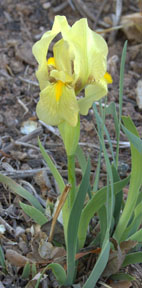
horticultural class: MDB chromosome
configuration: TTTT:48, TT:24 fertility: fertile
Distribution: Balkans, Eastern Rumania, Moldavia
Ditinguishing characteristics: one or two flowers, sometimes a spur, keeled bracts.
This is the smallest of the TTTT family, and the only species of this makeup that is usually unbranched. Flowers are yellow, but sometimes purple or brownish blends. I. balkana is widely regarded as a synomym of I. reichenbachii applied to the purple and brown forms of the species. It occurs in both diploid and tetraploid forms. Most, if not all, of the cultivated forms identified as balkana are tetraploid. This should not be taken to imply that forms identified as reichenbachii are all diploid, however. In fact, of the clones of I. reichenbachii for which chromosome counts are given in The Eupogon Iris Species in Cultivation, about 2/3 are tetraploid, including many yellow forms. (I do not know if this is true of clones in cultivation at the present time.) Mitra concludes that the tetraploid is a natural hybrid between the diploid I. reichenbachii and I. suaveolens, in much the same way that I. pumila arose from I. attica and I. pseudopumila. It is a frustration for hybridizers that the botanical names do not correspond neatly to the different karyotypes.
A form collected in the Vardar Gorge in Macedonia and distributred by Harald Mathes was presumed to be tetraploid, but this is now in doubt. (See I. sp. aff. reichenbachii ex Vardar Gorge, Macedonia.)
Expected to produce fertile offspring when crossed with TBs, BBs, tetraploid MTBs, and other TTTT species. Also expected to produce fertile offspring when crossed with I. pumila (offspring are members of the PPTT family, which includes the standard dwarfs). Crossing with regelias or other tetraploid arils is expected to produce AATT amphidiploid arilbreds (members of the fertile family that includes the fertile C. G. White arilbreds and their descendents).
Uses in hybridizing: The tetraploid forms have the potential to extend the TTTT family squarely into the SDB and even MDB range. Furthermore, there is the potential of creating arilbred dwarfs that are part of the same fertile family as the C. G. White arilbreds, making a line of fertile arilbred dwarfs and medians possible. The diploid forms are of less interest, since they are expected to produce sterile offspring in outcrosses, and in any case I. suaveolens has the same chromosome configuration and is widely regarded as a more attractive plant.
horticultural class: MDB chromosome
configuration: TT:24 fertility: fertile
Distribution: central Asia, from the Urals to the Tien Shan
Mountains
Distinguishing characteristics: small, tufty clumps, thin spathes.
Flowers mostly violet, seldom found in cultivation.
Expected to produce fertile offspring with diploid MTBs and other TT species.
Uses in hybridizing: Useful for adding its distinctive qualities to MTBs and related breeding lines. As a diploid, however, it is unlikely to produce fertile offspring in outcrosses to other types.
horticultural class:
MDB/SDB chromosome
configuration: TTTT:48 fertility: fertile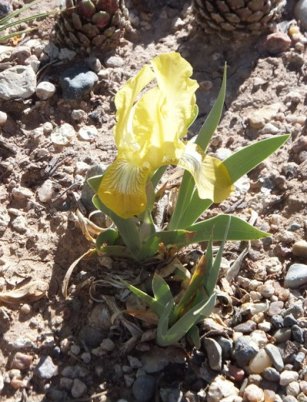
Distribution: Anatolia (central Turkey)
Distinguishing characteristics: 1-3 branches.
Like the other species from Turkey Ii. junonia and purpureobractea, this is a relative newcomer to cultivation. It is the most diminutive of the branched tetraploid species, and comes in a range of colors including violet, off-white, yellow, and yellow/brown bitones.
Expected to produce fertile offspring when crossed with TBs, BBs, tetraploid MTBs, and other TTTT species. Also expected to produce fertile offspring when crossed with I. pumila (offspring are members of the PPTT family, which includes the standard dwarfs). Crossing with regelias or other tetraploid arils is expected to produce AATT amphidiploid arilbreds (members of the fertile family that includes the fertile C. G. White arilbreds and their descendents).
Uses in hybridizing: Potential similar to that of Ii. aphylla, purpureobractea, and tetraploid reichenbachii. It offers the possibility of improving branching and bud count in the smaller medians and especially in the smaller arilbreds.
horticultural class: MDB chromosome
configuration: TT:24 fertility: fertile
Distribution: Balkans and northwest Turkey.
Distinguishing characteristics: falcate foliage, keeled bracts, one or two flowers.
Known to gardeners for decades as I. mellita, this diminutive species has long attracted the attention of dwarf iris breeders and fanciers. In the rubromarginata form, the sickle-shaped foliage is edged in red-violet. Flowers are often reddish violet, but may also be yellow, cream, or blended. Along with I. attica and I. pumila, I. suaveolens is one of the most diminutive of the bearded irises.
Expected to produce fertile offspring with diploid MTBs and other TT species.
Uses in hybridizing: A dedicated breeder might cross the different forms of this species and make selections for superior garden qualities. It also has some value in MTB breeding, to scale down lines that tend to grow out of class. Otherwise, its diploid nature makes it a problematic breeder, as it is expected to produce sterile seedlings when outcrossed to different types. Harald Mathes used a colchine-treated oncogelia x suaveolens seedling to launch his successful line of fertile small arilbreds.
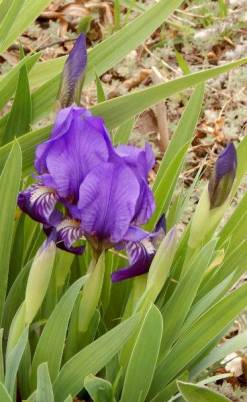
horticultural class:
SDB/IB chromosome
configuration: PPTT:40 fertility: fertile
Distribution: Portugal and Spain
Disntinguishing characteristics: long perianth tube, blue beards.
This violet iris of IB size is noted for its inclination to rebloom in the fall.
Expected to produce fertile offspring when crossed with SDBs and other PPTT types.
Uses in hybridizing: It might be interesting to cross this with SDB rebloomers, although otherwise it seems unlikely that it would have much to contribute to this already highly developed fertile family.
horticultural class: SDB chromosome
configuration: TT:24 fertility: fertile
Distribution: Caucasus, northeastern Turkey
Distinguishing characteristics:
This resembles a small I. aphylla, although the color range extends beyond violet to blue, white, and yellow.
Expected to produce fertile offspring with diploid MTBs and other TT species.
Uses in hybridizng: Like other small TT species, this can be useful in MTB breeding in working for smaller size and better branching. Otherwise, its potential is limited as a diploid that is expected to produce sterile offspring in outcrosses to other types.
horticultural class: MDB chromosome
configuration: TT:24 fertility: fertile
Distribution: eastern Caucasus
Distinguishing characteristics: long, narrow petals, sharply keeled bracts, two flowers, narrow falcate grayish leaves.
This unique diminutive species has narrow-petaled light violet flowers reminiscent of the regelias.
Expected to produce fertile offspring with diploid MTBs and other TT species.
Uses in hybridizing: Useful for adding its distinctive qualities to MTBs and related breeding lines. A number of hybrids have been introduced in recent years. As a diploid, however, it is unlikely to produce fertile offspring in outcrosses to other types.

horticultural class: MTB chromosome
configuration: TT:24 fertility: fertile
Distribution: Hungary and southeastern Europe
Distinctive characteristics: falls covered in red-violet or red-bown network of veins
This species, along with I. pallida, was a prime contributor to the gene pool of modern TBs and BBs, providing yellow, red, and brown coloration, winter hardiness, and wide branching. It is a delightful plant, bearing dainty flowers of yellow and red (sometimes cream and red-violet). Some other names:
flavescens
mangaliae
reginae
rudskyi
virescens
Expected to produce fertile offspring with diploid MTBs and other TT species.
Uses in hybridizing: I. variegata continues to be useful in MTB breeding, although as a diploid it is unlikely to produce fertile offspring in outcrosses outside this family.
The World of Irises, Bee Warburton and Melba Hamblen, eds. AIS, 1978.
Brian Mathew, The Iris. Timber Press, 1981, 1989.
The Eupogon Iris Species in Cultivation. MIS, 1970.
Clarence Mahan, Classic Irises and the Men and Women Who Created Them. Krieger, 2006.
October 2010
updated May 2016
|
|
Unless otherwise noted, all text and illustrations copyright Tom Waters and all photographs copyright Tom or Karen Waters. Please do not reproduce without permission.